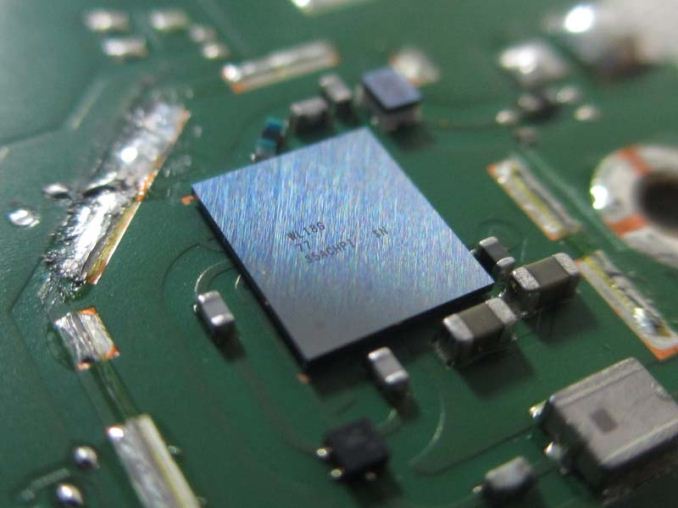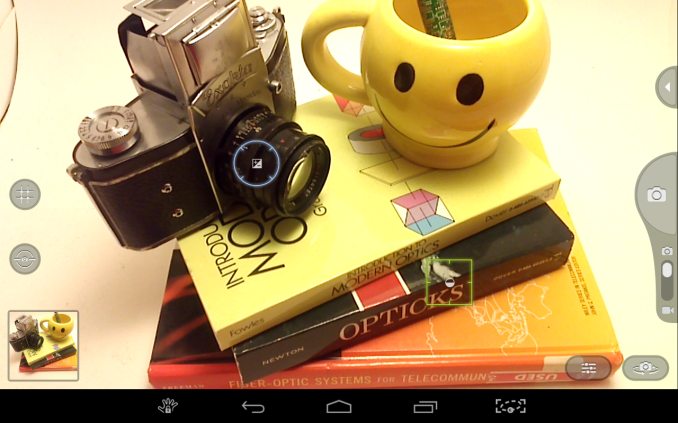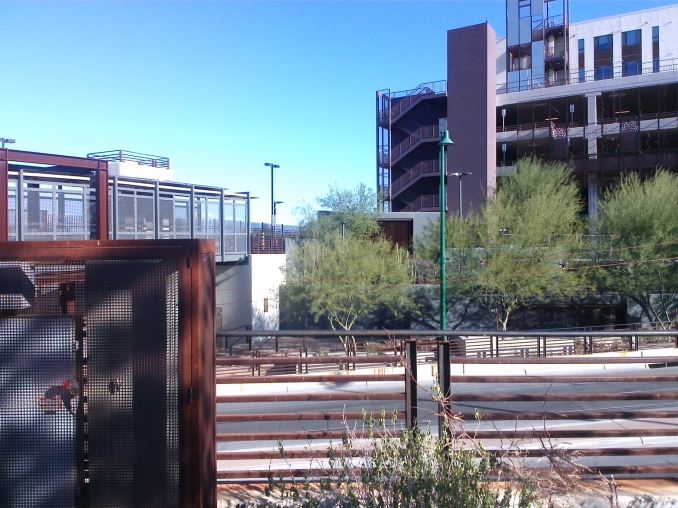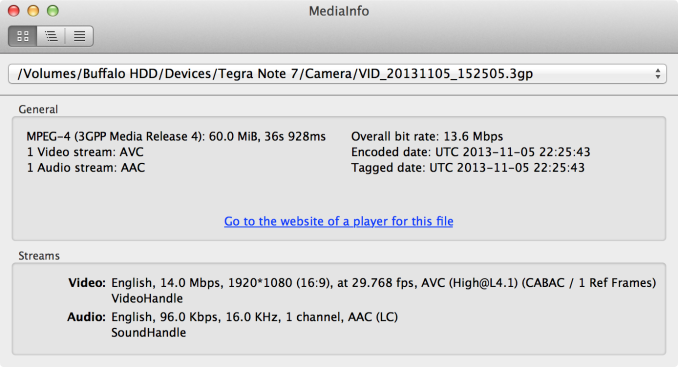NVIDIA Tegra Note 7 Review
by Brian Klug on November 12, 2013 9:01 AM EST- Posted in
- Tablets
- Mobile
- Tegra 4
- NVIDIA
- Tegra Note
WiFi, Camera, Speaker
WiFi
WiFi onboard Tegra Note is courtesy a TI Wilink 8 (WL18xx) series combo which also powers Bluetooth 4.0/LE. I keep hearing that TI has exited the mobile space completely, the reality is that TI continues to have a combo business and makes the PMICs for NVIDIA’s Tegra 4 SoC lineup. In addition the Tegra Note uses a TI GNSS (GPS and GLONASS).
Anyhow Tegra Note includes single stream 2.4 GHz WiFi, 802.11b/g/n, Miracast, and Bluetooth 4.0/LE. I’d love to see 5 GHz be a baseline, but that’s still not the case here, and also has the side effect of making the Tegra Tab incompatible with GameStream.

Throughput on iPerf in our test isn’t bad however among the 2.4 GHz only tests.
Camera
Cameras onboard Tegra Note are 5 MP on the rear, VGA on the front. The rear facing camera CMOS is an OV5690, which is a 1/4“ sensor with 1.4µm pixels, and the front facing camera CMOS is an OV7695 1/13” sensor with 1.75µm pixels. The rear facing camera is F/2.0 with a 4.0 mm focal length according to EXIF, although I’m not sure if I actually believe it, as the field of view looks a lot wider than I’d expect.
Regardless the Tegra Note is our first chance to see Tegra 4’s ISP and something else new, Camera Awesome for Android which is launching with Tegra Note 7. I’ve been complaining about the stock Android camera application for a while, which thankfully the Note 7 doesn’t include. Instead the default camera application is Camera Awesome, whose UI implements a number of the Chimera camera architecture features like tap to track, full resolution burst capture, and in a future release, always-on HDR.
Unfortunately the UI makes the same critical mistake that I see in the stock Android camera, and presents a 16:9 aspect crop of the 4:3 image formed on the sensor. The result is that images have more visible area above and below the preview area shown in the camera application.
Still image quality is actually a lot better than I expected it to be, but looks like a smartphone camera from a year or two ago. It’s adequate enough for a tablet but wouldn’t be competitive in the smartphone space, a few images are a bit hazy as well. I made sure to wipe the cover glass atop the camera between shots, but it’s possible this still contributed to the hazy appearance of a few of the sample shots. Tablets just need to have a camera these days, I’d argue that the one in Tegra Note gets the job done well enough.
Video on the rear facing camera is 1080p30, H.264 High profile with 1 reference frame, at 14 Mbps. I’ve uploaded the video to YouTube for quick viewing and to our servers if you want to see it without a transcode. Oddly enough the file format is .3gp, something I haven’t seen in quite a while. Video has an overexposed appearance and exposure distractingly hunts around quickly quite a lot even in the 40 seconds at the bench location, AF also runs quite a bit. I’m a bit disappointed in overall video quality and hope it improves dramatically with the December update. You can check off the box for video recording on Tegra Note, but not much beyond that.
Speaker
Since the HTC One, front facing speakers are starting to be a regular affair. The Nexus 7 (2013) shipped with stereo speakers, but they fire out the back. I measured the Tegra Note 7 using two songs that I’ve used for comparisons before and the sound data logger I’ve always used. I expected the Tegra Note to come out on top just because of the front facing speakers, oddly enough in terms of loudness the Nexus 7 was slightly ahead, although I suspect the A weighting I’ve always used might give it an edge.
| Speaker Loudness Comparison | ||||
| ASUS Nexus 7 (2013) | EVGA Tegra Note 7 | |||
|
Don't Move (dBA) |
82.11 | 81.92 | ||
|
Feel It All Around (dBA) |
83.44 | 82.90 | ||
The reality is that sound pressure level isn’t everything, it’s absolutely true that the Tegra Note has much more dynamic mids and lows than the Nexus 7 which sounds tinny in comparison. I'd subjectively say that the Tegra Note sounds way better, but is slightly quieter. The Nexus 7 is louder, but it's mostly high frequencies and much more tinny sounding. Tegra Note has speaker protection which runs on the Tegra 4 SoC as opposed to onboard a DSP inside a discrete component or elsewhere like I’ve seen for other products.




















87 Comments
View All Comments
ddriver - Tuesday, November 12, 2013 - link
Blame Java for that, it is one of the worst programming languages in terms of memory efficiency. And naturally, the lousy developers... heck, the skHype on my PC right now consumes 102 MB of ram, I'd say any developer who produces a simple messaging app that takes 100 mbs of ram idling should be fired out of a cannon into the sun.Dribble - Tuesday, November 12, 2013 - link
nexus 5, 7 have 2GB, some android tablets now have 3GB.iPad/iPhone handle less ram better but that's because they don't really multi task, and even then they don't have enough - e.g. browsing web have a load of tabs open and it'll keep reloading pages if you switch between them loosing anything you had done in them. I wouldn't buy an iPad with 1GB either.
BallGum - Tuesday, November 12, 2013 - link
I would say wait for the Nexus 10 2013.It has a larger screen, that much we know for sure.
A potential leak occurred a short while ago which I have detailed over at my blog here: http://theballofgum.blogspot.co.uk/2013/10/nexus-1...
I hope that information helps,
BallGum
ChanduG - Wednesday, November 13, 2013 - link
1080P needs 2GB RAM otherwise you won't need 2GB.ESC2000 - Wednesday, December 25, 2013 - link
Agree about the RAM.... really too bad esp RAM is crucial on Android. Course I don't need another tablet anyway bc I bought the nexus 7 2013 in July and got the Dell venue pro 8 in the awesome microsoft sale a few weeks back.lever_age - Tuesday, November 12, 2013 - link
I don't really follow the tablet market. Is there anything with a similar price with similar GPU performance? Seems like it makes a strong case for the price as a gaming device, but do people actually play those 3D games on Android? I mean... touchscreen lag, controls... I don't even want to get started. You can use a controller, but that kills the portability unless maybe we're talking Shield.TraderHorn - Tuesday, November 12, 2013 - link
Your 3d Mark physics score for the Asus T100 appears to be incorrect. I noticed the same thing in the initial review ofthe Asus T100. The number seems to mixed up with the graphics score.kdr9hu5 - Tuesday, November 12, 2013 - link
And I stopped reading after the bit about the display resolution... For $30 just get the Nexus 7.Pirks - Tuesday, November 12, 2013 - link
Tegra Note pwns Nexus 7 in game framerates, and it will pwn even next version of Nexus 7 judging by how poor Nexus 7 GPU showed off in on-screen benchmarks. If you are after gaming tablet, Tegra Note is light years ahead of competition right now.lmcd - Tuesday, November 12, 2013 - link
On-screen means that the T4 was doing 2/3 or less of the work.